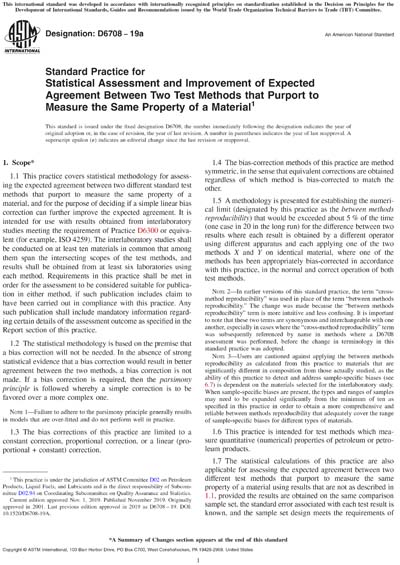Historical
ASTM D6708-19a
Standard Practice for Statistical Assessment and Improvement of Expected Agreement Between Two Test Methods that Purport to Measure the Same Property of a Material
1.1 This practice covers statistical methodology for assessing the expected agreement between two different standard test methods that purport to measure the same property of a material, and for the purpose of deciding if a simple linear bias correction can further improve the expected agreement. It is intended for use with results obtained from interlaboratory studies meeting the requirement of Practice D6300 or equivalent (for example, ISO 4259). The interlaboratory studies shall be conducted on at least ten materials in common that among them span the intersecting scopes of the test methods, and results shall be obtained from at least six laboratories using each method. Requirements in this practice shall be met in order for the assessment to be considered suitable for publication in either method, if such publication includes claim to have been carried out in compliance with this practice. Any such publication shall include mandatory information regarding certain details of the assessment outcome as specified in the Report section of this practice.
1.2 The statistical methodology is based on the premise that a bias correction will not be needed. In the absence of strong statistical evidence that a bias correction would result in better agreement between the two methods, a bias correction is not made. If a bias correction is required, then the parsimony principle is followed whereby a simple correction is to be favored over a more complex one.
Note 1: Failure to adhere to the parsimony principle generally results in models that are over-fitted and do not perform well in practice.
1.3 The bias corrections of this practice are limited to a constant correction, proportional correction, or a linear (proportional + constant) correction.
1.4 The bias-correction methods of this practice are method symmetric, in the sense that equivalent corrections are obtained regardless of which method is bias-corrected to match the other.
1.5 A methodology is presented for establishing the numerical limit (designated by this practice as the between methods reproducibility) that would be exceeded about 5 % of the time (one case in 20 in the long run) for the difference between two results where each result is obtained by a different operator using different apparatus and each applying one of the two methods X and Y on identical material, where one of the methods has been appropriately bias-corrected in accordance with this practice, in the normal and correct operation of both test methods.
Note 2: In earlier versions of this standard practice, the term “cross-method reproducibility” was used in place of the term “between methods reproducibility.” The change was made because the “between methods reproducibility” term is more intuitive and less confusing. It is important to note that these two terms are synonymous and interchangeable with one another, especially in cases where the “cross-method reproducibility” term was subsequently referenced by name in methods where a D6708 assessment was performed, before the change in terminology in this standard practice was adopted.
Note 3: Users are cautioned against applying the between methods reproducibility as calculated from this practice to materials that are significantly different in composition from those actually studied, as the ability of this practice to detect and address sample-specific biases (see 6.7) is dependent on the materials selected for the interlaboratory study. When sample-specific biases are present, the types and ranges of samples may need to be expanded significantly from the minimum of ten as specified in this practice in order to obtain a more comprehensive and reliable between methods reproducibility that adequately cover the range of sample-specific biases for different types of materials.
1.6 This practice is intended for test methods which measure quantitative (numerical) properties of petroleum or petroleum products.
1.7 The statistical calculations of this practice are also applicable for assessing the expected agreement between two different test methods that purport to measure the same property of a material using results that are not as described in 1.1, provided the results are obtained on the same comparison sample set, the standard error associated with each test result is known, and the sample set design meets the requirements of this practice, in particular that the statistical degree of freedom associated with all standard errors are at least 30. Requirements in this practice shall be met in order for the assessment to be considered suitable for publication in either method, if such publication includes claim to have been carried out in compliance with this practice. Any such publication shall include mandatory information regarding certain details of the assessment as specified in the Report section of this practice.
1.8 The methodology in this practice can also be used to perform linear regression analysis between two variables (X, Y) where there is known uncertainty in both variables that may or may not be constant over the regression range. The common acronym used to describe this type of linear regression is ReXY (Regression with errors in X and Y). The ReXY technique for assessing the correlation between two variables as described in this practice can be used for investigative applications where the strict data input requirement may not be met, but the outcome can still be useful for the intended application. Use of this practice for ReXY should be conducted under the tutelage of subject matter experts familiar with the statistical theory and techniques described in this practice, the methodologies associated with the production and collection of the results to be used for the regression analysis, and interpretation of assessment outcome relative to the intended application.
1.9 This international standard was developed in accordance with internationally recognized principles on standardization established in the Decision on Principles for the Development of International Standards, Guides and Recommendations issued by the World Trade Organization Technical Barriers to Trade (TBT) Committee.
Content Provider
ASTM International [astm]






